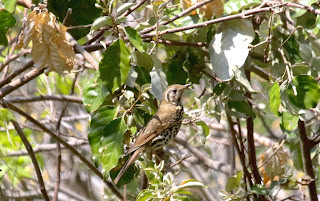 |
| Blue-and-white Flycatcher Cyanoptila cyanomelana |
 |
| male Yellow-rumped Flycatcher Ficedula zanthopygia |
 |
| female Yellow-rumped Flycatcher Ficedula zanthopygia |
 |
| male Mugimaki Flycatcher Ficedula mugimaki |
 |
| female Mugimaki Flycatcher Ficedula mugimaki |
 |
| Taiga Flycatcher Ficedula albicilla |
 |
| Radde’s Warbler Phylloscopus schwarzi |
 |
| Radde’s Warbler Phylloscopus schwarzi |
 |
| Siberian Blue Robin Larvivora cyane |
 |
Eastern Great Tit Parus minor
(the bird first caught my attention because of the greenish wash through
the belly...which turned out to be cast from the foliage below. It's also banded.) |
 |
| Daecheong-do |
 |
| Socheong's sleepy main village |
 |
| The sleepier second village |
There is still stuff from Gageo I’ve got to post, but that
can wait. I’ve been on beguiling Socheong Island for a few days now. It’s
uncomfortably close to North Korea, and the local garrison of grinning military
lads have a habit of testing their weapons at dusk – starting with rifles and heavy
machine-guns, and ending with what sounds like small artillery and miniguns.
So that’s had me biting my nails at night, heh heh. Guess you gotta let ‘em
know you’re still keen to have a go.
On all days (May 8-10), I’ve noticed: loads of Rufous-tailed
Robins; not much in the way of pipit or wagtail variety; plenty of Eyebrowed and
Grey-backed Thrushes; a good number of Yellow-browed and Tristram’s Buntings;
and a lot of Mugimaki and Yellow-rumped Flycatchers (but no Narcissus, which is
to be expected). There are also a dozen Taiga flycatchers around the island
(well-counted) – have there been similar high counts in the past?
The 4+ hour ferry from Incheon to Seocheong Island started
early, and so did many of the passengers. Many rather unwisely scoffed back
their greasy, spicy package-tour breakfasts, then washed it all down with the
ubiquitous Korean white lighting: soju. Less than an hour out of Incheon, the
seas angered. Pretty soon, the place looked like Jonestown, with ill Koreans
splayed out everywhere, some weeping. I, on the other hand, was feeling smug
and lovely, having popped my sweet sweet Korean Dramamine before boarding. The
boat was packed so I didn’t get a window seat, which sucked, but oh well.
I hit the ground running on Socheong, going on exploratory
walks around town in all directions, droning round the hills trying to figure
out how the island was put together.
To my dismay and horror, pheckin phyllos were dripping from
every leaf. I managed to pick through a lot of them, but I’ll admit I have a
ways to go with phylloscopus warblers. There were a goodly number of Dusky
Warblers around, with several Radde’s Warblers mixed in to make it interesting.
Pallas’s Leaf Warblers were also present in most leafy spots.
The day ended with 50 species…no shorebirds and almost no swallows. I was thrilled to find Chestnut-flanked White-eyes in many hilly
spots, a species I had long hoped to reconnect with after getting brief looks
many years ago. I call them “Chesties.” What? What?
At the end of the day, I glimpsed what I describe as a
scaled-down, inaccurate White’s Thrush. The next day, I would discover what it
was, and…it’s a good’un!


























































